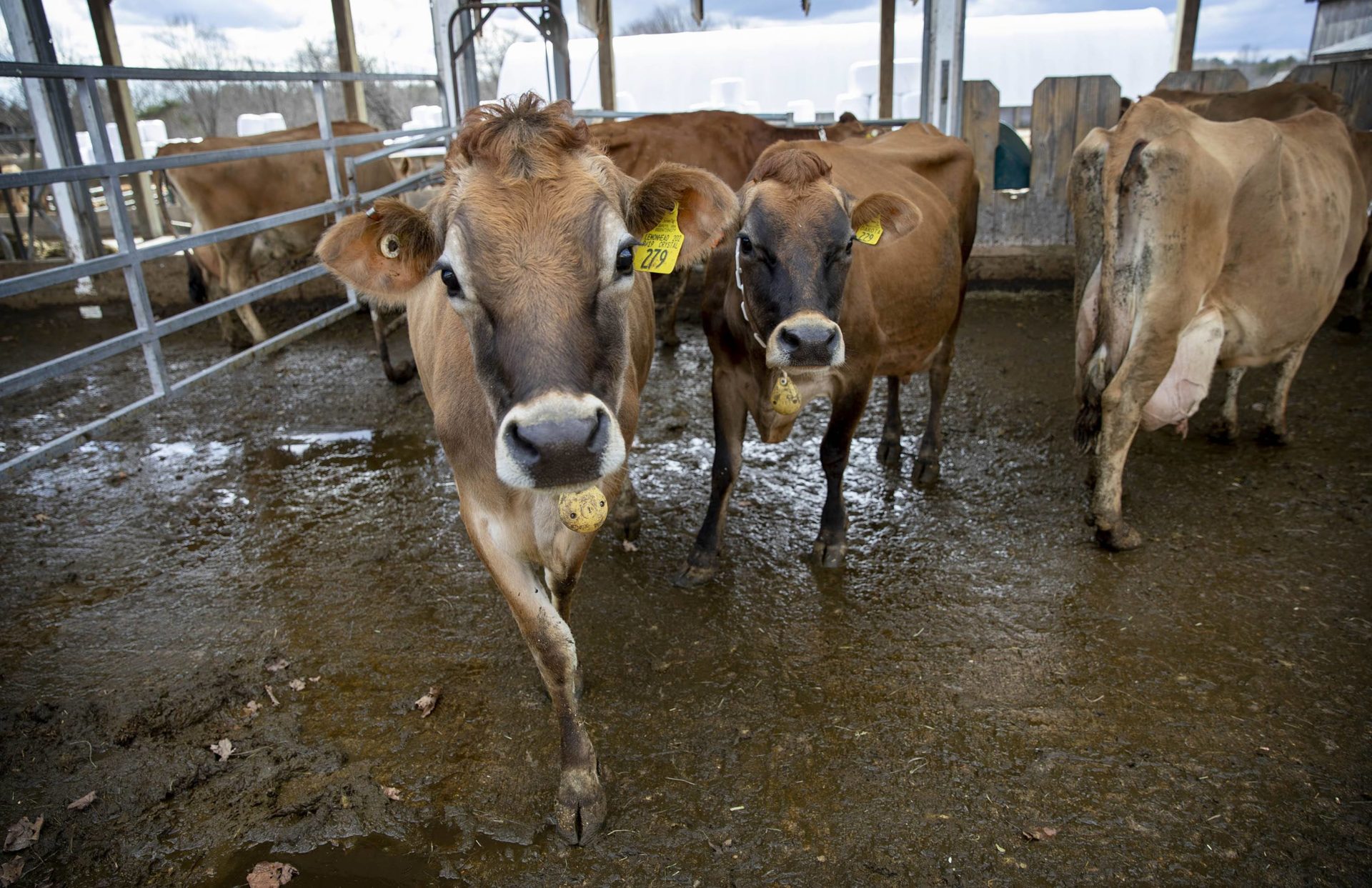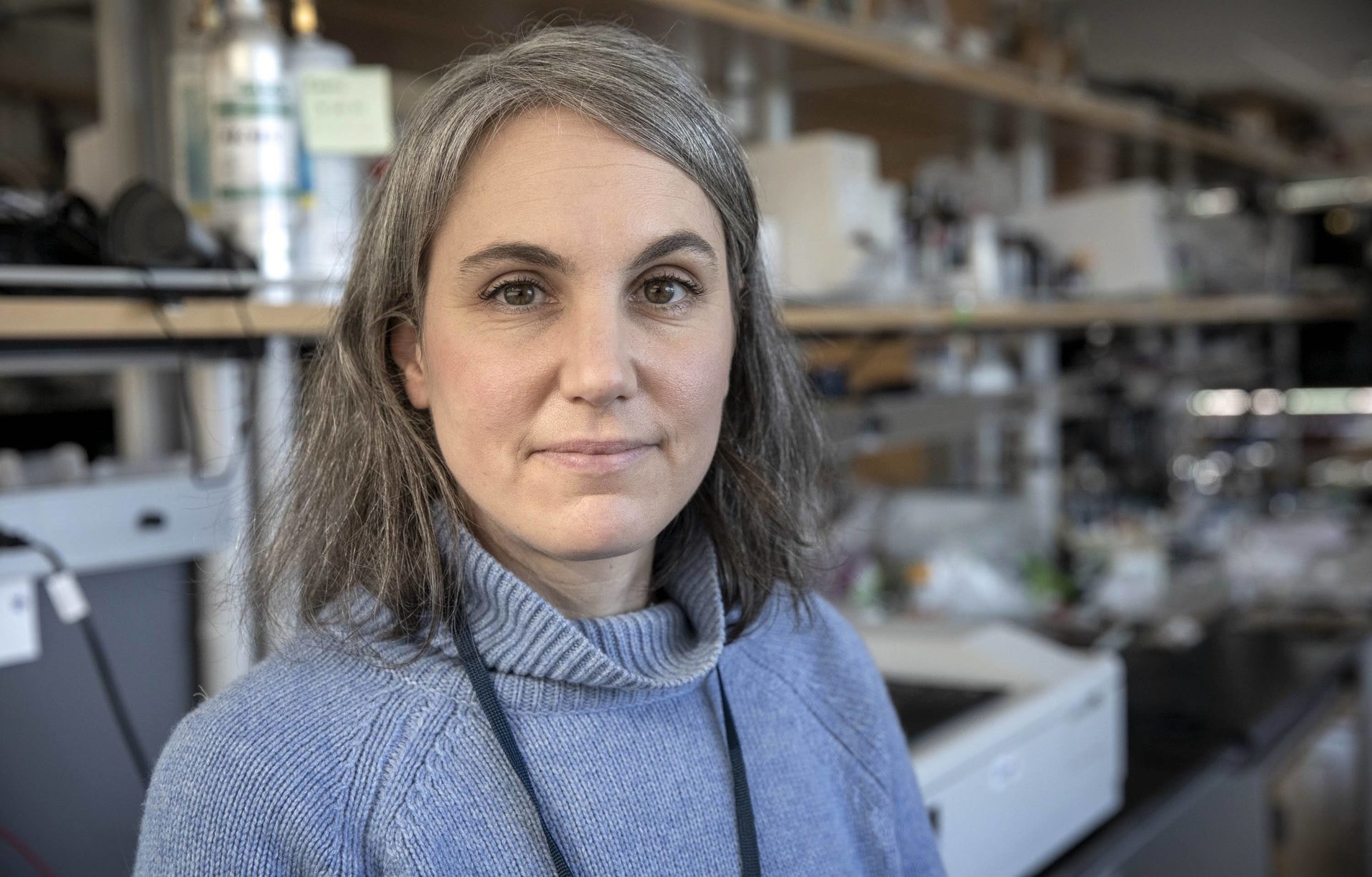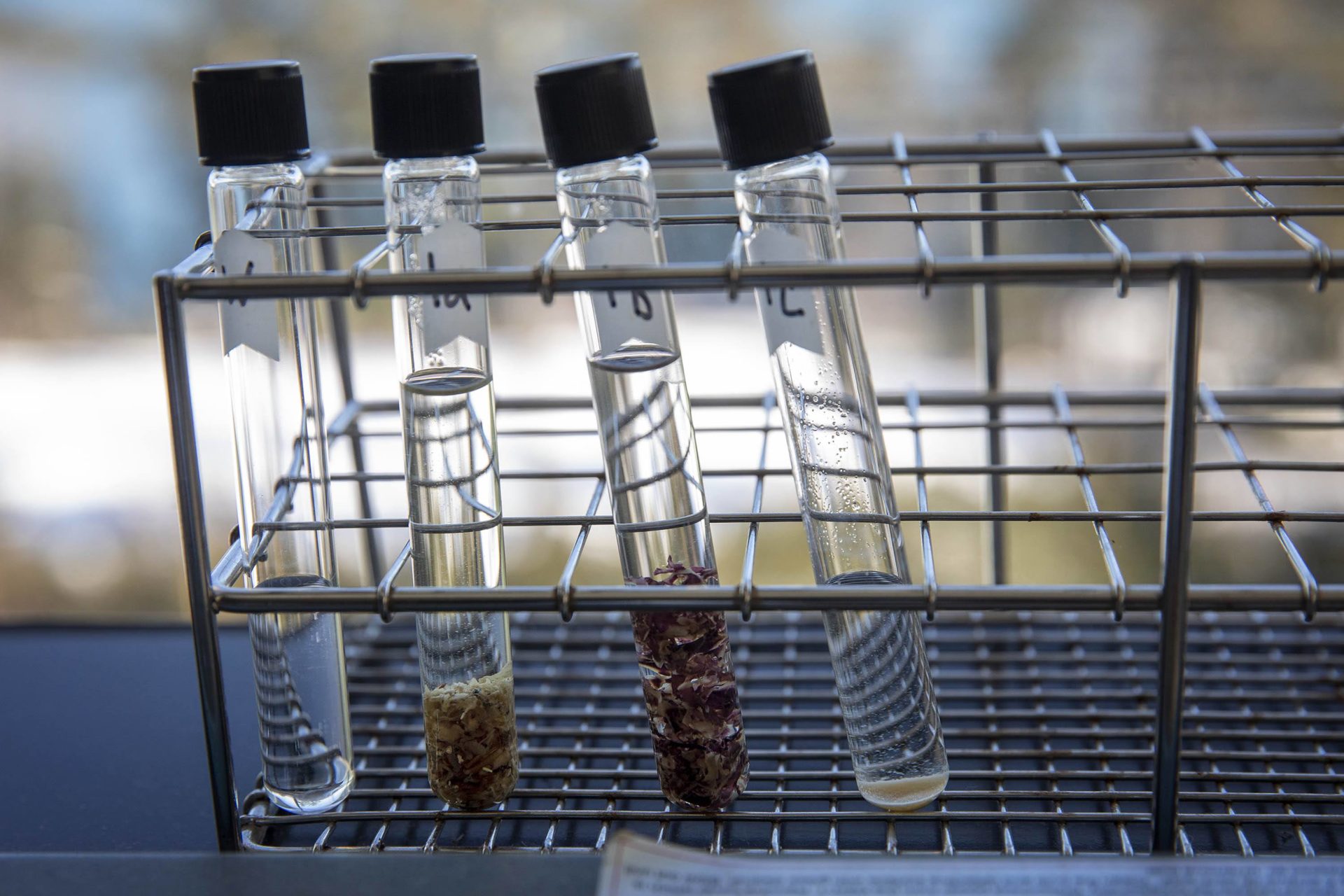Cow burps drive global warming. Scientists think feeding them seaweed could help

Inquisitive cows at Burley-Demeritt Organic Dairy Research Farm in New Hampshire. (Robin Lubbock/WBUR)
On a recent winter afternoon, a long line of brown Jersey cows lined up for feeding time, jostling for position.
At the end of the railing, Blueberry snorted in anticipation. Today, her meal at the University of New Hampshire’s organic dairy farm was a standard mixture of hay and grain.
But soon, she and her fellow dairy cows would have another ingredient added to the mix: seaweed.
This herd is part of a study looking into different types of seaweeds’ ability to reduce methane — a powerful greenhouse gas that cows release in a steady stream of burps.
“Cattle is the second largest source of methane in the United States,” said Andre Brito, associate professor of dairy cattle nutrition and management at UNH. “The industry as a whole is very interested in results to mitigate methane.”
A recent report from the Intergovernmental Panel on Climate Change (IPCC) found methane levels in the atmosphere are now higher than at any point in the past 800,000 years.
Methane is a significant driver of global climate change. Although it breaks down faster than carbon dioxide, it’s about 25 times more effective at trapping heat.
And bovine burps are the culprits; 95% of the methane released by cows comes from belching, a byproduct of their digestive system. Gas from cows and other livestock are a significant driver of methane emissions in the United States, second only to the oil and gas industry.
Brito is part of a team of New England scientists looking into whether feeding seaweed to the country’s roughly 90 million cattle could help cut their methane emissions.
Chewing over the problem
Here’s how it works. Cows are “ruminants,” mammals that can digest things that humans can’t, like grass. While people “ruminate” by “chewing on” complex or unpleasant thoughts, ruminants literally ruminate, regurgitating their food and chewing it further.
There’s a tradeoff to that process. A cow’s four-chambered stomach is “a habitat for billions and billions of microorganisms that basically digest the fiber for the animal,” Brito said. Some of those microbes then release methane as a byproduct, and the upstairs-downstairs journey of the food means the gas is belched out along the way.
Certain types of seaweed have special compounds that disrupt those microbes’ ability to make methane. So if you put some of that seaweed in the cows’ feed, they burp less methane.
But there’s a hitch. To date, the seaweed known to reduce methane most significantly — Asparagopsis taxiformis — grows in Australia.
Trying to grow it off the coast of the U.S. would be invasive. And growing it in land-based tanks would have a large carbon footprint.
Nichole Price, a senior research scientist at the Bigelow Laboratory for Ocean Sciences in East Boothbay, Maine, is working with Brito to find an alternate seaweed.

Nichole Price is a senior research scientist at Bigelow Laboratory and leads research on cattle methane solutions. (Robin Lubbock/WBUR)
“The question is, are there seaweed species that are native to different regions around the world, and specifically for us to the Northeast … that can be produced at a scale necessary to feed to the thousands head of cattle that we generate,” she said.
Price and her team have identified about a dozen local varieties of seaweed — and dozens more single-celled microalgae — that could have similar methane-inhibiting properties.
They’re now testing them in a lab full of fake cow stomachs, which Price calls their “bottle herd.”

The “bottle herd” in an incubator at Bigelow Laboratory. (Robin Lubbock/WBUR)
The bottle herd is a collection of glass vials sitting in an incubator. Each is filled with a brownish-yellow liquid: actual fluid from a cow’s stomach.
The scientists keep the bottles warmed to about 40 degrees Celsius, and then “feed” them little bits of seaweed.
Price and her research technicians let the fake stomach eat the seaweed, then measure the methane concentrations in the gas it emits.
Over time, the researchers hope to identify which seaweeds are most effective in disrupting the methane process in the cow’s stomach.

Research technician Gabriella Iacomo demonstrates how to remove a gas sample from a test bottle. (Robin Lubbock/WBUR)
A garden-based objection
But some argue there’s a simpler way to reduce methane emissions from the beef and dairy industries: stop eating beef and dairy.
“There would be an immediate benefit to simply reducing our consumption of meat, dairy and animal products,” said Evelyn Kimber, president of the Boston Vegetarian Society.
Cows are not only a major source of methane, she said. Beef production is also the top driver of deforestation of the world’s tropical rainforests, and a major consumer of fresh water.
She sees the seaweed study as a bit of a hack, trying to bypass a major systemic issue.
“Experimenting with feeding seaweeds to cows treats the animals as if they are machines, where you alter the fuel to alter the emissions,” she said.
Thinking of animals and nature as a resource to be manipulated got us into this problem, Kimber said. The same kind of thinking won’t get us out.

The University of New Hampshire’s Burley-Demeritt Organic Dairy Research Farm in Lee, NH. (Robin Lubbock/WBUR)
A mossy contender
But Brito thinks his herd of Jersey cows at the University of New Hampshire might be part of the answer.
Brito is testing a seaweed candidate identified in the bottle herd at Bigelow Labs — a red seaweed from the Gulf of Maine called “Irish Moss.” The cows are getting small amounts added to their regular feed.
Early results show methane reductions of about 15% to 20%, he said.
The results are preliminary, and the researchers will also test other types of seaweed. But Brito said he’s optimistic.
“If you have a consistent reduction of methane between 20 and 30%, I think they should be doing a very good step towards a more sustainable animal agriculture or dairy cattle agriculture,” he said.

Glass tubes containing different varieties of seaweed. (Robin Lubbock/WBUR)
A 20% to 30% reduction in methane is less effective than the Australian seaweed Asparagopsis, which has shown reductions of 80% in studies.
But the team calculates that if a seaweed reduced methane by 30%, could be sustainably mass produced, and fed to every cow in America, methane emissions could shrink by nearly two million metric tons. In terms of greenhouse gas emissions, that’s like taking 10 million cars off the road for a year.
That’s far from a sure bet. What is for certain: climate scientists say we need to deeply reduce methane emissions if we are to avoid the worst effects of climate change.
Seaweed-eating cows can be part of the solution — but not all of it.
This story from WBUR is part of the New England News Collaborative’s special coverage of Earth Week, exploring the impacts of climate change on our region’s food systems. For more stories, click here.
Climate change is overwhelming, but many New Englanders are looking for ways to do something about it by “living greener.” WBUR wants to help with their new 3-week newsletter “Cooked: the search for sustainable eats.” Understand how to reduce your impact on climate change through the food you eat & take actionable steps so YOU can make a difference! Sign up here.
